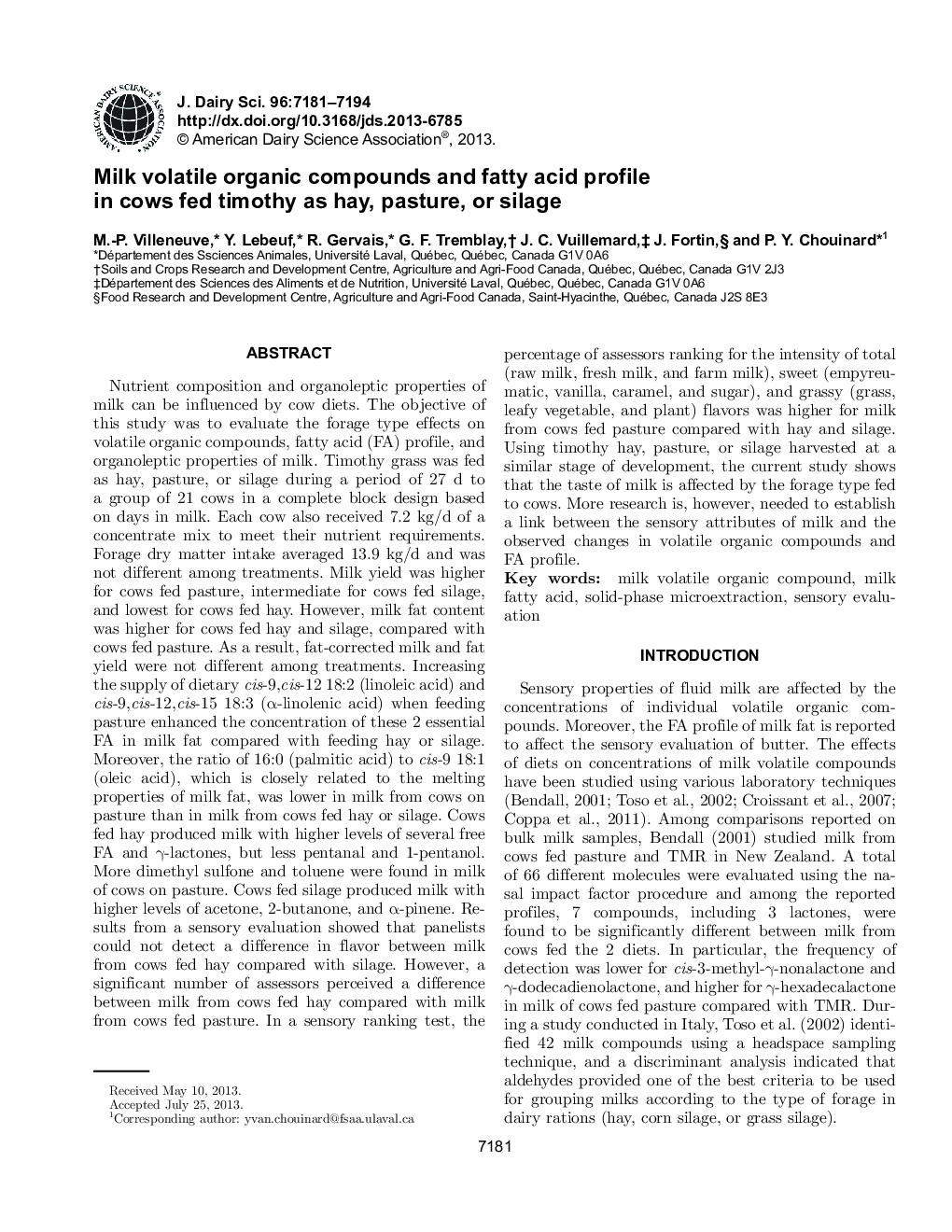| کد مقاله | کد نشریه | سال انتشار | مقاله انگلیسی | نسخه تمام متن |
|---|---|---|---|---|
| 10975050 | 1108030 | 2013 | 14 صفحه PDF | دانلود رایگان |
عنوان انگلیسی مقاله ISI
Milk volatile organic compounds and fatty acid profile in cows fed timothy as hay, pasture, or silage
ترجمه فارسی عنوان
ترکیبات آلی فرار شده از شیر و پروتئین اسید چرب در گاوهای خوراکی تیتوئی به عنوان یونجه، مرتع یا سیلیس
دانلود مقاله + سفارش ترجمه
دانلود مقاله ISI انگلیسی
رایگان برای ایرانیان
کلمات کلیدی
ترکیبات آلی فرار از شیر، اسید چرب شیر میکروکاکسازی جامد فاز، ارزیابی حسی،
موضوعات مرتبط
علوم زیستی و بیوفناوری
علوم کشاورزی و بیولوژیک
علوم دامی و جانورشناسی
چکیده انگلیسی
Nutrient composition and organoleptic properties of milk can be influenced by cow diets. The objective of this study was to evaluate the forage type effects on volatile organic compounds, fatty acid (FA) profile, and organoleptic properties of milk. Timothy grass was fed as hay, pasture, or silage during a period of 27 d to a group of 21 cows in a complete block design based on days in milk. Each cow also received 7.2 kg/d of a concentrate mix to meet their nutrient requirements. Forage dry matter intake averaged 13.9 kg/d and was not different among treatments. Milk yield was higher for cows fed pasture, intermediate for cows fed silage, and lowest for cows fed hay. However, milk fat content was higher for cows fed hay and silage, compared with cows fed pasture. As a result, fat-corrected milk and fat yield were not different among treatments. Increasing the supply of dietary cis-9,cis-12 18:2 (linoleic acid) and cis-9,cis-12,cis-15 18:3 (α-linolenic acid) when feeding pasture enhanced the concentration of these 2 essential FA in milk fat compared with feeding hay or silage. Moreover, the ratio of 16:0 (palmitic acid) to cis-9 18:1 (oleic acid), which is closely related to the melting properties of milk fat, was lower in milk from cows on pasture than in milk from cows fed hay or silage. Cows fed hay produced milk with higher levels of several free FA and γ-lactones, but less pentanal and 1-pentanol. More dimethyl sulfone and toluene were found in milk of cows on pasture. Cows fed silage produced milk with higher levels of acetone, 2-butanone, and α-pinene. Results from a sensory evaluation showed that panelists could not detect a difference in flavor between milk from cows fed hay compared with silage. However, a significant number of assessors perceived a difference between milk from cows fed hay compared with milk from cows fed pasture. In a sensory ranking test, the percentage of assessors ranking for the intensity of total (raw milk, fresh milk, and farm milk), sweet (empyreumatic, vanilla, caramel, and sugar), and grassy (grass, leafy vegetable, and plant) flavors was higher for milk from cows fed pasture compared with hay and silage. Using timothy hay, pasture, or silage harvested at a similar stage of development, the current study shows that the taste of milk is affected by the forage type fed to cows. More research is, however, needed to establish a link between the sensory attributes of milk and the observed changes in volatile organic compounds and FA profile.
ناشر
Database: Elsevier - ScienceDirect (ساینس دایرکت)
Journal: Journal of Dairy Science - Volume 96, Issue 11, November 2013, Pages 7181-7194
Journal: Journal of Dairy Science - Volume 96, Issue 11, November 2013, Pages 7181-7194
نویسندگان
M.-P. Villeneuve, Y. Lebeuf, R. Gervais, G.F. Tremblay, J.C. Vuillemard, J. Fortin, P.Y. Chouinard,
